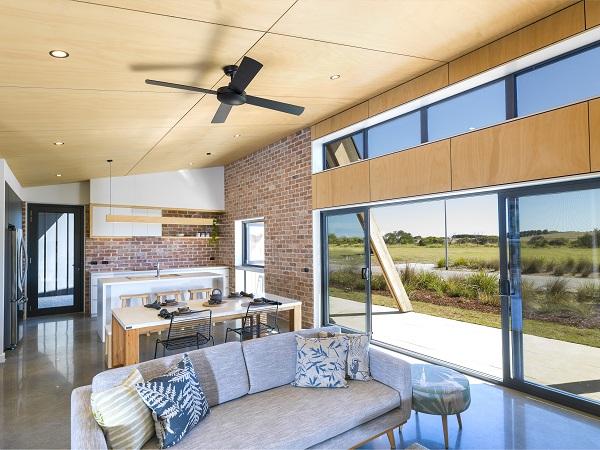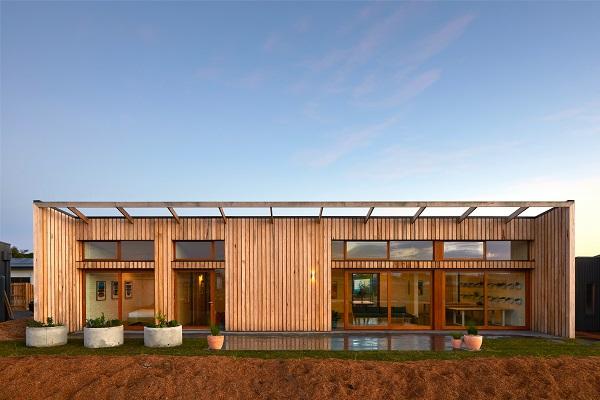In May, the Department of Environment and Energy published new quarterly emissions data that showed greenhouse gas emissions increased 0.8% in the December 2017 quarter. This is up 1.5% compared to the same quarter in 2016 and is the third consecutive year Australia has seen an increase in greenhouse gas emissions.
Since the built environment accounts for approximately 40% of these emissions, sustainable housing can play an important role in helping reduce Australia’s carbon footprint.
“Our housing sector is a major part of the national carbon emission footprint so if we can’t build our homes to a high standard then we’re locking in higher energy use and higher carbon emissions for the future,” says Australian Ecosystem director and The Cape project director Brendan Condon.
“Passive solar, energy efficient homes also perform much better in hot spells and heat waves, which are already becoming far more frequent, and are much better for the health and safety of residents factoring in a future hotter climate.”
The Cape is a sustainable, highly-efficient housing development located in Cape Paterson, Victoria that encourages home owners to live carbon neutral.
All 220 homes being built as part of the project have mandatory minimum standards, including a 7.5 star energy efficiency rating, 2.5kW of solar energy installation and 10,000L of rainwater storage for the garden and toilet flushing.
The whole estate is gas free - houses have eliminated gas for hot water, cooking and heating through the use of highly efficient reverse cycle heating and cooling systems, induction cook-tops and electric hot water heat pumps.
This, combined with shading, thermal mass, energy-efficient LED lights and an electrical system that is solar storage and battery-ready, helps the homes’ occupants reduce their energy usage.

The CORE 9 prototype built at The Cape integrates sustainable materials with a low embodied energy, and a considered mix of solar power, solar hot water, and rain water harvesting, to reduce and or totally eliminate household utility bills. The home was built by TS Constructions and designed by Beaumont Concepts.
According to modelling by the Alternative Technology Association, many homes at The Cape are expected to have annual running costs as low as $500, and some are expected to completely eliminate their energy bills and generate annual cash rebates of between $90 and $400 for residents.
“By combining passive design, solar energy and energy-efficient appliances, and eliminating the use of expensive gas from the estate, we’re de-coupling our houses from rising energy costs and as a result, we’re finding they have a fraction of the operating costs of conventional homes,” says Brendan.
“What we’ve done is set up a process and method that can be followed by any builder around Australia because the homes are still being built with standard building materials. We aren’t using expensive or experimental materials, just standard ones such as plantation timber, plywood, corrugated iron and weathertex cladding. The only difference is we’ve optimised these for energy-efficiency by focusing on orientation, insulation, thermal mass and shading.”
While many developments in Australia now incorporate similar features into their homes, The Cape is unique in its holistic approach to sustainability. The development is situated on 100 acres and approximately half of this is dedicated to open space, including walking paths, wetlands, community gardens, habitat restoration and sports facilities. It also includes an urban farm with advanced wicking garden beds that only require watering once a week during summer months. Already, the farm has produced approximately $30,000 worth of produce for residents and the local community.
Additionally, many homes in The Cape feature electric vehicle charging points.
“If we maintain the same standard through the project then we’re on target to eliminate half a million dollars of stationary energy costs per annum in the estate compared to a conventional estate. We also have a stretch target of eliminating half a million dollars of petrol spend by 2030 through the integration of electric vehicles,” says Brendan.

Victoria's first 10-star home at The Cape, built by The Sociable Weaver
Before stage one construction began in 2016, The Cape spent $300,000 on a training process for the local builders to ensure they could deliver the minimum standards. Five of Victoria’s leading sustainable architects and designers, as well as two energy efficiency experts were recruited as part of this process. The interactive learning process saw architects develop design concepts and floorplans, with builders providing feedback on materials and building systems. Energy efficiency experts optimised the building plans to achieve higher passive solar performance with minimal or no additional costs.
“We went through a series of iterations to improve the designs and this resulted in our first 10 fully-costed, fully-specified homes. Through this process we not only trained the builders but also reduced the premium to build high-performance, energy-efficient housing,” says Brendan.
“To build sustainably 10 years ago it was quite expensive but recently we’ve seen the cost of solar panels lower and the performance of energy efficient home operating systems improve. At the same time we’ve seen the cost of electricity double so there’s now a big economic performance gap opening up between conventional and sustainable homes and that’s only going to get bigger.”
As a result, Brendan says The Cape is being approach by a number of other developers who are interested in stepping up and lifting their standards.
“We’re executing this development as a thought leadership project in the industry and that’s why we’re open sourcing our house designs,” says Brendan.
This means people anywhere in Australia can go onto The Cape website and download sustainable house designs to use and learn from. Brendan says so far there have been approximately 40,000 downloads of house designs and construction drawings.
Construction is currently underway on stage two of the project and there are three more stages planned for 2019, 2020 and 2021. All homes are expected to be completed by 2023.

Inside the CORE 9 home at The Cape